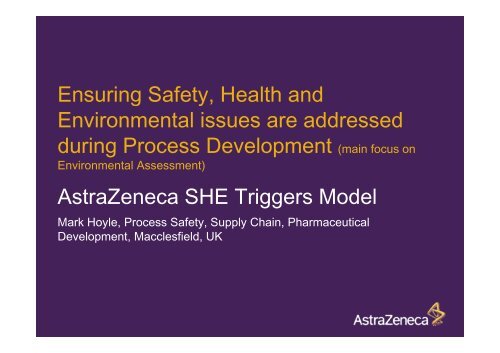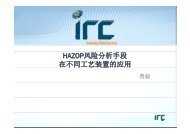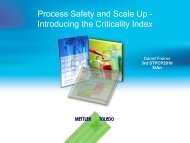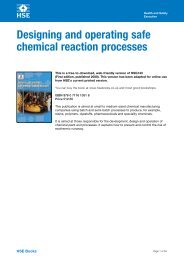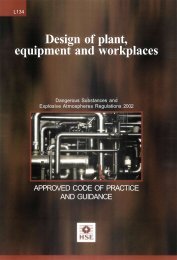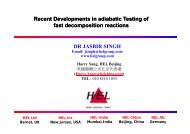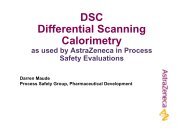Ensuring Safety Health and Ensuring Safety, Health and
Ensuring Safety Health and Ensuring Safety, Health and
Ensuring Safety Health and Ensuring Safety, Health and
Create successful ePaper yourself
Turn your PDF publications into a flip-book with our unique Google optimized e-Paper software.
<strong>Ensuring</strong> <strong>Safety</strong>, <strong>Health</strong> <strong>and</strong><br />
Environmental issues are addressed<br />
during Process Development (main focus on<br />
Environmental Assessment)<br />
AstraZeneca SHE Triggers Model<br />
Mark Hoyle, Process <strong>Safety</strong>, Supply Chain, Pharmaceutical<br />
Development, Macclesfield, UK<br />
t or pro oject nam me<br />
partmen<br />
Dep
The ‘Model’<br />
• Flexible tool to identify when key SHE activities should be<br />
undertaken. Ensures SHE activities are not on the critical<br />
path. (Project Manager has overall responsibility - but does not carry<br />
out the individual activities)<br />
Trigger 1 Trigger 2 Trigger 3 Trigger 4 Trigger 5<br />
Project Start Route Evaluation Route Freeze Process Freeze Detailed Process<br />
Freeze / TT<br />
GENERAL ACTIVITIES THROUGHOUT DEVELOPMENT<br />
FGLPD<br />
~ 6 Years<br />
TT<br />
General set of fActivities iti Throughout h Development (<strong>and</strong> need reviewing i at all triggers)<br />
Review of Chemical Registration Requirements<br />
Review any Transportation Requirements<br />
Review any <strong>Safety</strong> Data Sheet (SDS) Requirements<br />
Process Risk kAssessment for Internal Manufacture<br />
- Review full Chemical Hazard Assessment<br />
- Review Operational Hazards
The Model<br />
• Does not cover all the direct SHE activities that need<br />
to be carried out on a day-to-day basis. These are<br />
covered by local procedures <strong>and</strong> work practices with<br />
support from the locally-based AZ SHE Advisers.<br />
• The general activities need reviewing by the Project<br />
Manager / project team at regular intervals as these<br />
could (<strong>and</strong> do) change considerably during<br />
development <strong>and</strong> can take significant time to<br />
complete.
Outline of requirements at each Trigger<br />
FGLPD<br />
~ 6 Years<br />
TT<br />
Trigger 1<br />
Project Start<br />
Trigger 2<br />
Route Evaluation<br />
Trigger 3<br />
Route Freeze<br />
Trigger 4<br />
Process Freeze<br />
Trigger 5<br />
Detailed Process<br />
Freeze / TT<br />
(Information gathering <strong>and</strong> initiation on safety/tox work –most work is done or initiated at this stage!)<br />
Obtain SHE Information from the Discovery team<br />
Information to Process <strong>Safety</strong> for Preliminary Assessment<br />
Assign HAZR&D Group to Materials<br />
Request HAZR&D Report<br />
Review Chemical Hazard Information - Decide if existing<br />
Information is adequate<br />
Submit structures for SAR assessment (starting materials <strong>and</strong><br />
intermediates)<br />
Develop Occupational <strong>Health</strong> Hazard Evaluation Requirements<br />
(Tox Testing) in Conjunction with Occupational Toxicology<br />
Consult Occupational Toxicology to Review Route Selection with<br />
Respect to <strong>Health</strong> Effects
Outline of requirements at each Trigger<br />
FGLPD<br />
~ 6 Years<br />
TT<br />
Trigger 1<br />
Project Start<br />
Trigger 2<br />
Route Evaluation<br />
Trigger 3<br />
Route Freeze<br />
Trigger 4<br />
Process Freeze<br />
Trigger 5<br />
Detailed Process<br />
Freeze / TT<br />
Submit New Compound in Development Form to AZ SHE (should be one that will pass<br />
through initial manufacture with potential for long-term use) – ensures all functions (Occupational<br />
Toxicology, Chemical Registration Team, Environmental Risk Assessment, Dangerous Goods<br />
team <strong>and</strong> Process <strong>Safety</strong> (within Pharmaceutical Development) are all aware of the compound<br />
<strong>and</strong> its initial route (just in case they have not been involved previously)<br />
Preliminary Environmental Review – regulatory review carried out by SHE group<br />
(Environmental Risk Assessment)<br />
Environmental Risk Assessment/Preliminary Environmental Assessment - the review above<br />
directly feeds into the risk assessment (tool) <strong>and</strong> identifies major issues.<br />
Aim of Environmental Assessment Process is to ideally prevent, then minimise <strong>and</strong> ultimately to<br />
render harmless pollution to air, water <strong>and</strong> l<strong>and</strong> (from our processes)
Outline of requirements at each Trigger<br />
FGLPD<br />
~ 6 Years<br />
TT<br />
Trigger 1 Trigger 2 Trigger 3 Trigger 4 Trigger 5<br />
Project Start t<br />
Route Evaluation Route Freeze Process Freeze Detailed Process<br />
Freeze / TT<br />
Environmental Assessment at Route Freeze<br />
Review Occupational <strong>Health</strong> Hazard Evaluation Requirements<br />
(SAR Evaluation/Tox Testing) in Consultation with AZ SHE
Outline of requirements at each Trigger<br />
FGLPD<br />
~ 6 Years<br />
TT<br />
Trigger 1 Trigger 2 Trigger 3 Trigger 4 Trigger 5<br />
Project Start t<br />
Route Evaluation Route Freeze Process Freeze Detailed Process<br />
Freeze / TT<br />
Environmental Assessment at Process Freeze<br />
Review Occupational <strong>Health</strong> Hazard Evaluation Requirements<br />
(Tox Testing) in Consultation with AZ SHE
Outline of requirements at each Trigger<br />
FGLPD<br />
~ 6 Years<br />
TT<br />
Trigger 1<br />
Trigger 2<br />
Trigger 3<br />
Trigger 4<br />
Trigger 5<br />
Project Start Route Evaluation Route Freeze Process Freeze Detailed Process<br />
Freeze / TT<br />
Request Full <strong>Safety</strong> Data Sheets<br />
Final Environmental Review<br />
Final Chemical Registration Review<br />
SHE TT Report
Environmental Assessments<br />
• Aim to design out significant Environmental issues<br />
• Provide an auditable trail of E issues (through development)<br />
• Accessibility to ALL chemists <strong>and</strong> engineers is key<br />
• Make it easier for non-experts to engage (with the process) making it<br />
more success<br />
To put statements t t on materials such as this (below) into an easily<br />
understood / usable format<br />
Exhibits high/moderate toxicity …. subject to a m<strong>and</strong>atory UK<br />
Environmental Quality St<strong>and</strong>ard of 50μg l -1 (freshwater) <strong>and</strong> 40μg l -1<br />
(seawater). UK….discharges contributing >1% EQS considered significant.<br />
Risk assessment at European level …recommendation that it be added to<br />
the Priority Substances List of the Water Framework Directive. EU<br />
legislation - category 3 reprotoxin….may increase pressure from<br />
regulators <strong>and</strong> may result in a more stringent EU-wide EQS. Likely to be<br />
rapidly removed from water by volatilisation, which may pose issues during<br />
biotreatment….
Why do we do these assessments:<br />
• Integrated Pollution <strong>and</strong> Prevention Control (IPPC) Regulations<br />
(UK, <strong>and</strong> similar in EU) - required to demonstrate Best Available<br />
Technology (BAT) for the whole route (EU based regulations)<br />
• Regulators can ask at any time – with no warning<br />
• Corporate Responsibility (‘Fits’ (Fits our Corporate SHE Objectives)<br />
• Aim for continuous improvement in the sustainability of all our<br />
activities by, amongst other things, economising on the use of natural<br />
resources <strong>and</strong> working to eliminate pollution.<br />
• Train, empower <strong>and</strong> require individuals to take personal responsibility<br />
for safety, health <strong>and</strong> the environment.<br />
• Cannot outsource responsibility for SHE issues<br />
• Regardless of regulations, toxic materials are toxic wherever h<strong>and</strong>led<br />
• Annual reporting - metrics provide data for reporting of waste<br />
• Business Drivers<br />
• Promotes transferable processes<br />
• Risk management – if we don’t do this we are at risk (of breaching<br />
permit to work <strong>and</strong> loss of reputation).<br />
ti
‘Fits’ AZ Corporate SHE Objectives<br />
• Objective 1<br />
Aim to eliminate all work-related related injuries <strong>and</strong> cases of<br />
ill health by providing a safe <strong>and</strong> healthy work<br />
environment <strong>and</strong> promoting health & wellbeing.<br />
• Objective 2<br />
Aim for continuous improvement in the sustainability<br />
of all our activities i i by, amongst other things,<br />
economising on the use of natural resources <strong>and</strong><br />
working to eliminate pollution.<br />
• Objective 3<br />
Train, empower <strong>and</strong> require individuals to take<br />
personal responsibility for safety, health <strong>and</strong> the<br />
environment.
Approach based on ‘Inherent <strong>Safety</strong><br />
Principles’<br />
Prevent<br />
More<br />
emphasis<br />
throughout<br />
Environmental<br />
Assessment<br />
Process<br />
Minimise<br />
Render harmless<br />
Likelihood of success<br />
increases as we<br />
move back up the<br />
Development<br />
process
AZ (Pharm Dev) SHE Trigger Model & the<br />
Environmental Assessment Process<br />
FGLPD<br />
~ 6 Years<br />
TT<br />
Trigger 1<br />
Trigger 2<br />
Trigger 3<br />
Trigger 4<br />
Trigger 5<br />
Project Start Route Evaluation Route Freeze Process Freeze Detailed Process<br />
Freeze/TT<br />
Environmental<br />
Assessment<br />
Submit NCID (PD)<br />
Complete PER (AZSHE)<br />
Risk Assessment / PEA (AZSHE/PD)<br />
Environmental<br />
Assessment<br />
Final Environmental<br />
Review<br />
Prevent<br />
Minimise<br />
Prevent Prevent<br />
Minimise<br />
Minimise<br />
Render<br />
Render<br />
Render<br />
Harmless Harmless Harmless
Environmental Risk Assessment Tool<br />
• Excel Interface<br />
• Assumptions & limits<br />
Assumptions & limits<br />
• Substance (Process) Mass intensity metric<br />
• Likelihood calculator<br />
• Actions (AZ or contractor)<br />
• Environmental Risk Profile
Environmental Risk Assessment Tool<br />
1. Consequence/Hazard Score against each material<br />
4 – Very High Environmental impact material (major issue, legislation will<br />
prevent use or severely restrict emission in short/medium term)<br />
3 – High environmental impact material (significant issue)<br />
2 – Medium Issue (e.g. UK class A VOC)<br />
1 – (relatively) Low Issue<br />
1 2 3 4<br />
Acetone<br />
Ethanolamine<br />
Diisopropylamine<br />
2-Methyltetrahydrofuran<br />
Acetic Acid<br />
1,4-Dioxane<br />
Diethyl ether<br />
Acetonitrile<br />
Thionyl Chloride<br />
N-Methyl pyrrolidone<br />
1,5-Cyclooctadiene<br />
Methyl Iodide<br />
Dichloromethane<br />
Ethyl Bromoacetate<br />
Copper<br />
1,3-Chloro-2-propanol<br />
Diglyme<br />
Dimethyl Sulphate<br />
Dimethylacetamide<br />
Epichlorohydrin<br />
Benzyl Mercaptan<br />
Butane<br />
Isopropyl chloride<br />
Isopropyl Ether<br />
Allyl Alcohol<br />
Butyl Cyanide<br />
Butyronitrile<br />
Isobutyl chloroformate<br />
Iodoethane<br />
Nitrobenzene<br />
Phosphorus<br />
Pentachloride<br />
Acrylonitrile<br />
Benzyl Chloride<br />
Freon 22<br />
Isopropyl Bromide<br />
n-Butyl acetate Methane Trichlorotriazene N,N-Dimethylformamide
Environmental Risk Assessment<br />
Tool<br />
2. Likelihood Score against each material:<br />
Mass of<br />
material<br />
used in Stage (Kg)<br />
Likelihood =<br />
×<br />
Mass of API (Kg)<br />
Projected<br />
TPA of<br />
API<br />
• Ranking<br />
Low < 100<br />
Medium < 1000<br />
High > 1000<br />
•Risk = Consequence x Likelihood
Environmental Risk Assessment
Environmental Risk Assessment<br />
Spreadsheet entry of Consequence Score <strong>and</strong> Likelihood<br />
(H/M/L – from Stage Mass Intensity x API tonnage calc)
Calculating Likelihood Scores<br />
(Excel Spreadsheet – for ease)
Risk Profile<br />
Environmental Risk Profile<br />
AZDXXXX<br />
Risk Matrix<br />
Plot Risks<br />
Likelihood<br />
al API<br />
dicted Annua<br />
nes)<br />
kg API) x Pred<br />
irement (tonn<br />
substance/k<br />
requi<br />
eg (kg<br />
>10 3 H 11, 29, 30, 31, 34 12, 33<br />
>10 2 M<br />
1, 4, 5, 6, 7, 8, 9,<br />
13, 15, 16, 18, 20,<br />
21, 22<br />
3, 17, 23, 24, 27 2, 10, 14, 19, 25 26<br />
Updated Assessment
Risk Profile<br />
Environmental lRi Risk Profile<br />
AZDXXXX<br />
Risk Matrix<br />
Plot Risks<br />
Likelihood<br />
eg (kg<br />
substance/k<br />
kg API) x Pred<br />
dicted Annua<br />
al API<br />
irement (tonn<br />
nes)<br />
requ<br />
>10 3 H 11, 29, 30, 31, 34 12, 33<br />
>10 2 M<br />
1, 4, 5, 6, 7, 8, 9,<br />
13, 15, 16, 18, 20,<br />
3, 3, 17, 17, 23, 29, 24, 3027 2, 2, 10, 14, 14, 19, 19, 3225 26<br />
27, 28, 21, 31, 22 33<br />
Further in-house Tools (to help make decisions<br />
based on the Risk Assessment (quickly <strong>and</strong> with relative ease)<br />
• Solvent Selection Guide + ‘light’ version for<br />
Discovery<br />
• Lifecycle impact added (cradle to gate)<br />
• Acid <strong>and</strong> Base Selection Guide<br />
• Substance Avoidance Database<br />
• Alkylating Agent Selection Guide<br />
• Amide Formation Reagent Selection Guide<br />
• API Removal Tool
Successes<br />
• Linear 7 step sequence convergent 3 step sequence<br />
• solvent 300 to 50 kg/kg API<br />
• water 85 to 25 kg/kg API<br />
• reagents 35 to 10 kg/kg API<br />
• 80% cost reduction<br />
• Eliminated use of 1,2-dimethoxyethane<br />
• EU VOC Directive<br />
• Between critical clinical deliveries, post route freeze<br />
• Process Mass Intensity targets have now been included in the<br />
Process Mass Intensity targets have now been included in the<br />
Environmental Assessment protocol.
Benefits<br />
• Efficient process (re-appraisal of the ‘model’ in 2008 streamlined it<br />
somewhat <strong>and</strong> incorporated the ‘risk management’ approach to<br />
Environmental assessment)<br />
• Simple visual guide for development teams<br />
• Easily updated through development (<strong>and</strong> beyond)<br />
• Promotes interaction between AZ SHE, Pharmaceutical<br />
Development <strong>and</strong> outsourcing partners<br />
• Differentiates relative project risk<br />
Oncology hundreds kg<br />
Cardiovascular, neuroscience hundreds tonnes<br />
,<br />
• Allows appropriate resource allocation
Conclusions<br />
• Considered d to be an improved framework for the<br />
continuing implementation of Green Chemistry<br />
• Easier interpretation & clearer focus for chemists,<br />
engineers <strong>and</strong> outsourcing partners.
Co-authors<br />
Magnus Bergqvist<br />
Stephen Evans<br />
Dan Horner<br />
James Baird<br />
Acknowledgements<br />
Vyv Coombe<br />
Caireen Hargreaves<br />
Andy Wells<br />
Wesley White


